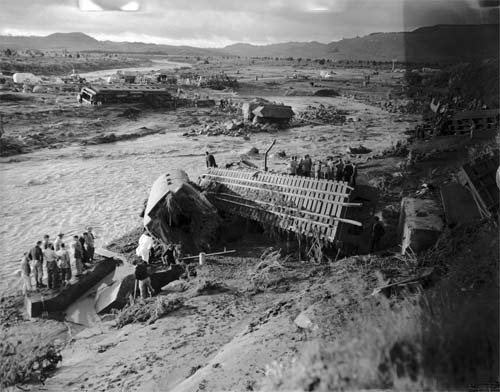
A railway bridge collapsed and killed a 151 train passengers in New Zealand on this day in 1953 after the structure was damaged by a devastating volcanic mudflow.
The steam engine and all five second-class carriages of the Wellington to Auckland express plunged into the Whangaehu River at Tangiwai when the crossing gave way.
The Christmas Eve tragedy happened when a lahar – the contents of a burst volcanic crater lake - cascaded down Mount Ruapehu and surged into the river.
One of the structure’s piers was destroyed by the unusual phenomenon only minutes before the train got there and then collapsed under the weight of the locomotive.
Many of the victims, including a family of five on their way to visit relatives for Christmas, were washed 75 miles into the sea and their bodies were never found.
A British Pathé newsreel shows the scale of the devastation – the worst rail crash in New Zealand history – with an aerial view of carriages strewn across the valley.
The footage also shows 21 unidentified victims being buried in a mass grave at a funeral service attended by the Duke of Edinburgh.
He and the Queen had been in New Zealand as part of the first overseas tour of her reign when the tragedy happened.
The monarch delivered a message of sympathy to her people in New Zealand in her annual Christmas Day message, which was broadcast from Auckland.
She also awarded the George Medal to train guard William Inglis and passerby Cyril Ellis, who saw the danger and alerted the driver by waving a torch at the trackside.
The train, which was travelling at 40mph, could not come to a halt in time to avert the disaster at Tangiwai, which means “weeping waters” in the Mauri language.
But he helped save 134 lives after three first-class carriages, the guard's van, and a postal van remained safely on the track.
When Ellis saw that the fourth first-class coach was teetering on the edge, he and Inglis went inside to help passengers off.

While the two were inside, the carriage snapped from its couplings and fell into the river.
But Ellis and Inglis were still able to rescue all but one of the 16 passengers and save themselves.
The only victim in the first-class carriage was a little girl who drowned after being trapped in her seat.
The death toll also included 148 second-class passengers, the driver and fireman.
Also among the victims was Nerissa Love, the fiancée of New Zealand cricketer Bob Blair, who was touring South Africa at the time.
In the aftermath, a system was developed to provide early warnings of lahars from Mount Ruapehu, the highest peak in the country’s North Island.
The 9,177ft active volcano is particularly prone to the phenomenon, whose name is derived from the Javanese language.
Occasionally, the crater lake of steaming water marking the vent, becomes so full that it breaks through a weak point in the surrounding ice.
This sends a torrent of water, ice, rock and mud down the eastern side of the mountain and into the Whangaehu River.
However, lahars prior to 1953 had failed to damage the bridge, which has now been reinforced.
A similar sized lahar struck again in 2007 and the structure was unharmed.
The early warning systems also stopped trains and motorists at Tangiwai before the mudflow hit.
Tuesday 24 December 2013
http://uk.news.yahoo.com/on-this-day--new-zealand-rail-bridge-collapses-and-kills-151-in-christmas-eve-volcanic-mudflow-disaster-151131695.html

0 comments:
Post a Comment